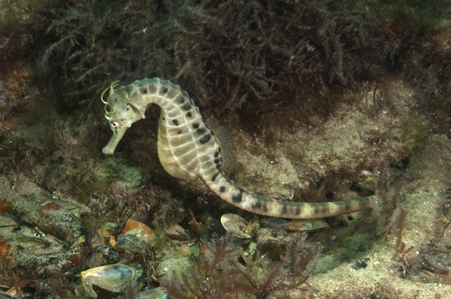General Description
Body compressed with a large abdomen, completely encased in bony rings; snout relatively long, tubular; tail long, prehensile; top of head often with filaments. Coloured to match surrounding sponges and macroalgae - usually yellowish, to red and brown, often with irregular darker spots and a broadly banded tail. To 30 cm.
Biology
Bigbelly Seahorses often cling to sponges, macroalgae such as kelp holdfasts, and other structures on reefs. They are the largest and most common seahorse in southern waters, and are locally abundant in some areas, including under piers in Port Phillip Bay.
Habitat
A range of habitats from low rocky reefs in shallow estuaries, to deep tidal channels and deeper coastal reefs, in depths of 0-100 m.
Reefs
Distribution guide
New Zealand and south-eastern Australia.
Species Group
Fishes › Seahorses, pipefish and allies
Depth
Shallow (1-30 m)
Deep ( > 30 m)
Water Column
Max Size
30 cm
Diet
Carnivore
Commercial Species
No
Global Dispersal
Recorded in Australia
Identify
Conservation Status
- DSE Advisory List : Not listed
- EPBC Act 1999 : Not listed
- IUCN Red List : Data Deficient
- Fisheries Act 1995 : Protected Aquatic Biota






